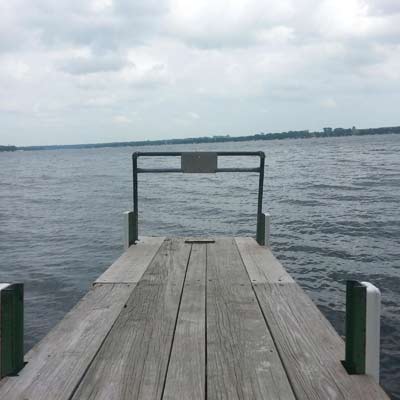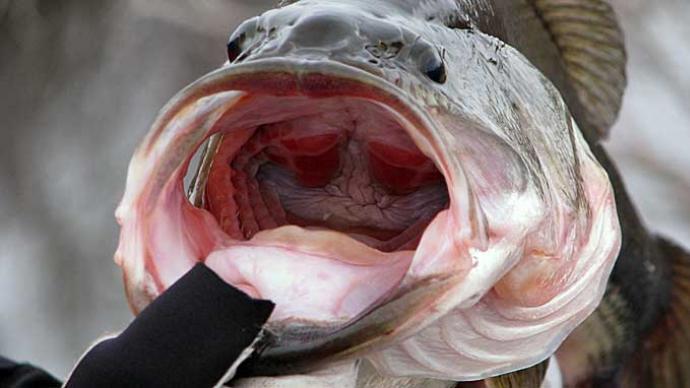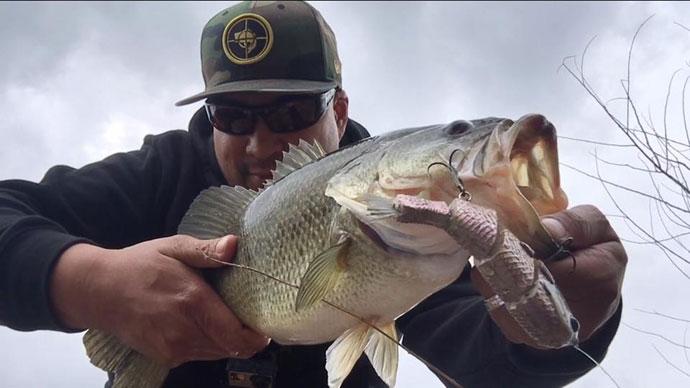
The best way to fish for bass is not a lure. It isn’t a secret spot. And it’s definitely not being lucky. It’s a calculation. Plug in known or observed pieces of information, and you’ll know where and how to catch them.
Bass are conditioned by their environment, and they react to changes within it. They don't decide to swim into a creek or hunker down along a river channel. Everything, from water temperature to the most plentiful food sources, directs their actions. Identify those conditions, apply an understanding of their effects on bass, and you’ll find them fast, regardless of where you’re fishing.
There are six variables in this bass-catching calculation. Most are simple observations made on the water. The balance is easily obtainable bits of general information about where you're fishing. The magic happens when you bring them together. And the answer it provides is better than any amount of luck.
-
What type of water are you fishing?
Start with this fundamental piece of information. It sets the stage for everything else because bass are conditioned by their environment. They need to make the best of where they swim.
- Reservoirs: These manmade impoundments are where a fair portion of bass anglers spend their days, and the sport has made most of its growth. They’re filled with structure, but cover is often limited. Most bass are baitfish-oriented, often moving great distances over a year’s course.
- Natural lakes: Bass in these bodies of water, which include lakes Champlain and Okeechobee, relate to cover more than structure. That and relatively little water inflow mean changes seem to happen slowly, and bass stay in one place longer.
- Rivers: Regardless if it’s large or small, the amount of current — and direction if you’re fishing tidal water — dictates bass location and activity. Like most gamefish, bass prefer eddies, where moving and slack water meet.
-
Which species of bass are you targeting?
Bass behavior is directed by genetics, too. Each of the three most-pursued species of bass act differently. Even strains within each are unique. Northern-strain largemouth, for example, handle springtime cold fronts much better than their Florida-strain relatives.
- Largemouth: You wouldn’t be all wrong if you called these the laziest bass. They shun all but the weakest currents, preferring to lounge in shallow water and around heavy cover. They’re the most active in low-light conditions — dirty water, overcast skies, or choppy surfaces.
- Smallmouth: Though bruisers swim in some Southern waters, these symbols of northern fisheries aren’t afraid of current and thrive in shallow and deep water. They feed most aggressively on sunny days, especially in clear water.
- Spotted: In many respects, spots look like largemouth but act like smallmouth. They’re most commonly found in deep or clear water. Their activity seems less weather dependent, and they eat finesse and power presentations equally well.
-
What is the season?
Bass movements are seasonally dependent. Increasing daylight, for example, is believed to pull bass into shallow water in spring. But distance and depth are relative to each body of water. Wintertime largemouth, for example, are routinely caught through the ice in less than 10 feet of water on northern natural lakes.
- Spring: Most bass move from wintering holes to spawning spots, so look for them along the outside edges of shallow flats, points, and creek channels that lead to shallow water. After spawning, many reverse these movements, though some will remain if heavy cover is available.
- Summer: Most bass spends the hot-weather months on specific spots such as humps, river channels, and outside weed edges. While weather, water conditions, and baitfish may relocate them, they never seem to stray far from these deep-water spots.
- Fall: Cooling water and less dissolved oxygen in deep water push baitfish and bass toward shallow water. Windblown flats on natural lakes and shallow water in the back of creek arms on reservoirs are prime destinations.
- Winter: After feeding all fall, further drops in water temperature push bass back to deep-water spots, particularly those with a sharp drop. But they’re relative to the body of water. For example, a wintering hole on a river may be only a few feet deeper than a summer spot.
-
What is the weather?
Image
Light is one environmental condition that affects bass behavior. Knowing how it affects bass makes it easier to find the ones that you’re chasing. Photo by Pete M. Anderson While seasonal movements may provide an overall direction, day-to-day factors dictate timing, speed, and route. Watching these helps you quickly narrow in on where bass will most likely be on their journey.
- Light: Bass act differently under clear and overcast skies. Smallmouth, for example, are most aggressive under sunny skies. It’s the opposite for largemouth. But aggressiveness and catchability aren’t synonyms. Finding largemouth on sunny days can be easier when they tuck tight to cover.
- Precipitation: Rain, whether plentiful or lacking, affects bass location. Falling rain can make bass active by reducing light levels and creating runoff that stains or muddies clear water. Lots of it raises the water level, inviting bass into the newly flooded cover. Dry spells corral bass into fewer places.
- Wind: Breezes may appear to direct bass, but it’s actually the microscopic meals of baitfish that are at its mercy. Baitfish and bass simply follow along. While wind may not move bass, it can make those in its path more active.
-
What are the current water conditions?
Bass can't survive without water, so water quality and conditions are essential. They also can change quickly. A day of rain, for example, can make portions of reservoirs too muddy to fish.
- Level: A nod to the amount of water in a lake, river, or reservoir, it determines the quantity and quality of shallow cover and structure. If it drops low enough, whole backwaters, for example, can be eliminated. High water puts more in play, spreading bass throughout the newly flooded cover.
- Clarity: Clear, stained, or muddy, sediment-filled runoff is the main determinator. Wind or current can roil soft bottoms, and some natural lakes are stained by tannic acid. In general, bass become less guarded as water takes on more color.
- Temperature: Bass are cold-blooded, so the warmer the water, for example, the more active they are. While temperature ebbs and flows with the seasons, warm-water discharges, cold-water springs, and even dark-colored dock floats on sunny days can affect it locally.
-
What structure and cover are available?
Forward-facing sonar has revealed that more bass use open water than previously thought. But you’re still most likely to run into them around structure — changes in the bottom contour — and cover — items on the bottom. Bass use both as ambush points when feeding and follow them during seasonal movements.
- Channels: The remnants of flooded rivers and creeks in reservoirs they’re found in rivers, too. Bass use the edges of this deeper water as protection, ambush points, and to move into and out of shallow water. Deep-water channels are summertime hotspots.
- Points: Most noticeable when extending from shore, they also are underwater, jutting off a shoal or channel edge. Bass use them to feed, especially if the wind blows across them or as highways, moving between deep and shallow water.
- Flats: These expanses of similar depth can be found in shallow or deep water. Bass use both to feed, but they often hold on to specific spots on them, such as a rock pile.
- Drops or ledges: Bluffs are a visible example of this type of structure, whose depth rapidly changes in a short distance. Most bass use them during the hottest and coldest months, finding the perfect depth with minimal horizontal movement.
- Wood: Bass are attracted to laydowns, stumps, and bushes for many reasons. They provide ambush points for feeding along with protection from predators and shelter from environmental changes.
- Rock: Whether in a naturally formed pile or purposely built riprap wall, its crevices hold a year-round smorgasbord of baitfish and crawfish for bass. Shallow rock absorbs sunlight, releasing heat into the surrounding water. That slight temperature rise activates nearby bass in winter and spring.
- Aquatic vegetation: Grass means bass — that longtime quip rings true for largemouth and many smallmouth. It offers everything wood provides but in a denser format. So, bass use vegetation for longer, sometimes relocating within a bed but rarely leaving as long as it remains green.
- Manmade: Some of the most productive pieces of cover are artificial. While docks and boathouses may be the most popular among anglers and bass, bridge abutments, sunken roads, house foundations, seawalls, and even fish attractors are home to plenty of fish.
A Little About Lures
One variable that’s missing is lure choice. Lures are tools; each works best in a specific situation. Hollow-bodied frogs, for example, are perfect for extracting bass from thick shallow-water cover. But they won’t work when you need to dredge up bass holding on a river-channel ledge 25 feet deep. So, you can only determine lure choice once you locate bass.
Putting It Together

Identifying these six variables is a big step toward your destination — quickly catching more and bigger bass. But it's only the first one. You need to assemble them into a pattern by weighing their importance within the current situation. Practice will make it second nature. Here are some examples to get you started.
Scenario No. 1: You launch your boat in a northern natural lake, hoping to catch some largemouth bass. It's early May, and the clear water is in the mid-50s. The sky is overcast, and a steady breeze is pushing waves.
- The type of water tells you largemouth bass will relate more to cover than structure, and they're less likely to travel long distances. So, begin looking near shallow spawning spots, starting in the lake's northwestern corner, which warms up first.
- The wind and overcast skies combine to activate bass. While the water temperature contributes, it isn't warm enough for spawning, so these prespawn bass will likely be bunched up, probably in submerged aquatic vegetation outside a spawning flat. The conditions will make them active, perfect for a reaction bait such as a bladed jig, lipless crankbait, or jerkbait. You’ll need to make long casts to overcome increased visibility in clear water.
Scenario No. 2: It’s summertime, and you’re headed for a midsized river filled with hard-fighting smallmouth. The sky is clear, but recent rains have added current and stained the water, which is in the mid-70s.
- The season, water color, and current mean these smallmouth are in full-on feeding mode. They'll be set up in eddies, waiting for disoriented baitfish or dislodged crawfish to be swept by. Laydowns, bridge abutments, and the inside of channel bends are excellent places. Stick to ones on shallow stretches of the main river, saving the backwaters for winter and spring.
- The conditions call for loud and noisy lures, which are easy to find in the dirty water and satisfy the smallmouth’s increased aggression. A big spinnerbait or shallow-running crankbait with round sides are good choices.
Scenario No. 3: It’s fall, and you’re idling away from the launch on a sprawling reservoir. You’re hunting spotted bass under sunny skies. The water is clear or slightly stained, and its temperature is falling.
- Schools of baitfish are the main focus of these bass in fall. And they're all headed to shallow water, whether that's the top of a shoal, back of a cove, or up a creek arm, along structure such as a long point or creek channel. Wind will redirect them, so follow its direction. Keep covering the water until you find them.
- Small flashy lures that move fast will do an excellent job of imitating baitfish without giving bass time to decide not to strike in the clear water. Topwaters are a good start, but keep a jerkbait and shallow-diving crankbait rigged, too.
While this bass-catching calculation is most helpful in locating bass, it can be run in reverse. Work it backward to determine why you found them there if you stumble across some. Knowing that can help you find other similar spots and provide insight into how bass react to their environment. That’ll help you find them faster in the future.




